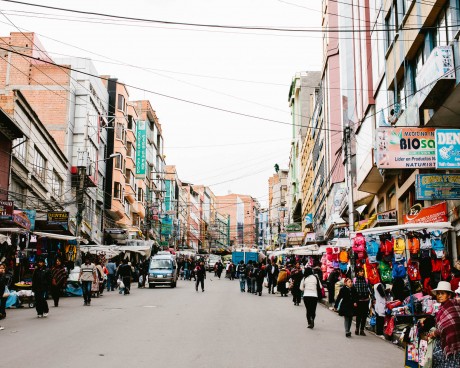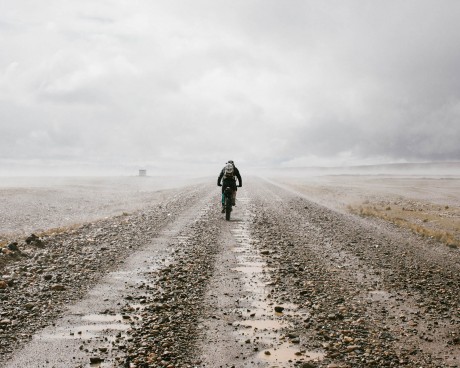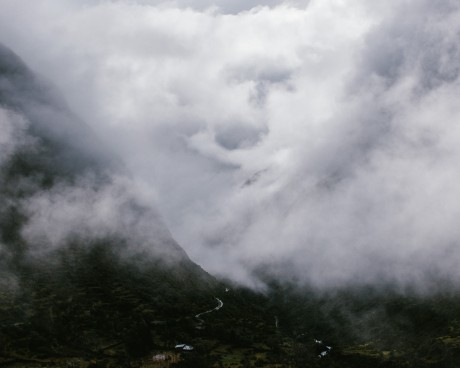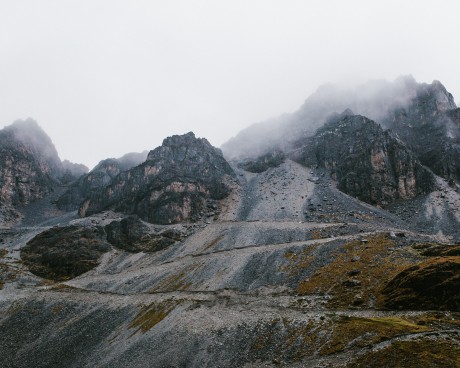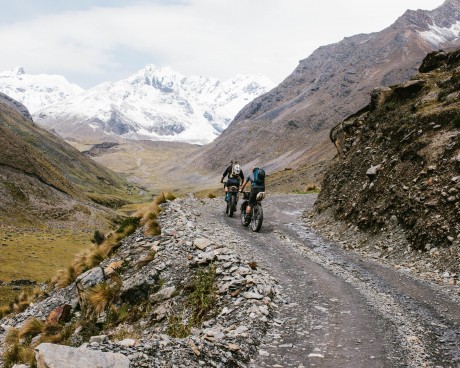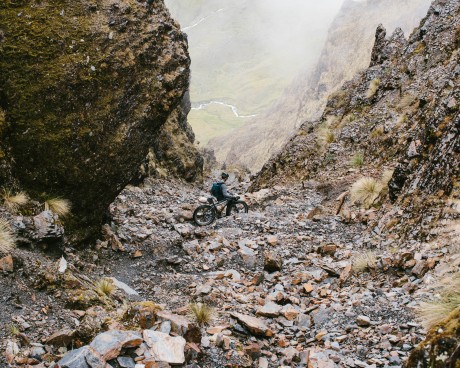
Sunchuli Pass: Lord Nerd Beta
SECTION No1 Sunchuli Pass: Route Prospectus
We went to Bolivia because of the mines.
Everywhere else in the world roads go where roads go and trails go where trails go. There is very little confusion about which is which, and it’s clear where one ends and the other begins. Roads are wide, paved or graded, and maintained to some degree. Trails get rad. In Bolivia, because of the mines, the situation is more fluid.
If gold was discovered on the top of Mt Whitney, and California didn’t give a fuck about large scale mining and environmental stewardship because it was the poorest country in South America, somebody with three snow shovels lashed to the front of a minivan would figure out how to build a road to the top. Now imagine thousands of Whitneys, only 40% taller, steeper and more rugged. That’s the Cordillera Apolobamba.
That’s why we went to Bolivia. To ride a network of the world’s most ambitious, ludicrous roads. Roads that defy physics. Roads that weave throughout an ancient and venerable Alpine Wonderland that is currently transitioning into to Tolkien’s Mordor.
SECTION No2 Route Map
SECTION No3
Bike Setup Art by Greg Davis
- 1. Clearly the correct choice for Sunchuli pass.
- 2. Comfortable even during (and after) a day of Jurassic Period washboard roads.
- 3. Highly functional even when fully loaded.
- 4. Descends like Hermann Maier.
- 1. Load the heaviest items closer to the seatpost for the best weight distribution.
- 2. Excellent for light but bulky gear; the Mr. Fusion is stable as a rock.
- 3. Ideas: sleeping bag, clothing, camp shoes (e.g. sandals or Authentic Bolivian Slippers).
- 1. Best for your heaviest/densest objects.
- 2. Ideas: food, stove/kitchen, tools, water.
- 1. The main compartment is good for high volume gear, while the smaller zippered pouch is perfect for all those easily accessible goods.
- 2. Ideas: sleeping bag, tent, sleeping pad, clothing; snacks, phone, camera.
- 1. You are always going to start a trip loaded heavily, so if possible lighten your backpack daily by moving weight on to the bike as food/fuel weight disappears.
- 2. Ideas: water (3 liter capacity preferable), active layers, accessories (e.g. gloves, hats), more snacks, book, sun screen, first aid, commonly used tools, rain shell, head lamp.
- 1. Everything Cages lashed to the fork legs are necessary for additional gear carrying capabilities.
- 2. Use Porcelain Rocket stuff sacks to hold any leftover dense/heavy items, like fuel and parts/tools.
- 1. Tape over them to reduce wear on your framebag.
SECTION No4
FYI Basic/Assorted Tips
- Before you visit Bolivia you will need a Yellow Fever shot. You should know that this means putting Yellow Fever eggs into your blood stream. Neat.
- The La Paz airport is a Hot&High airport. This means that landing and taking off are extra challenging. Our research shows that American Airlines is the only international carrier that flies into La Paz, the story goes that AA execs were busy doing blow during the airport draft because they got stuck with La Paz. The airport feels like it was converted from a bus station, not necessarily desirable. The good thing is that their planes are old, like wall paper, cigarette lighter, and VHS tapes old, so the vibe, the whole experience, is at least consistent.
- If your like us, when looking of hotel’s in La Paz you will search for the place that CIA operatives, Mineral Barons, and Dignitaries –both foreign and domestic– choose to stay. But you don’t need to. Just stay where we stayed, Hotel Rosario.
- Our average daily elevation was over 14,000 feet. For perspective, the highest point in the contiguous United States is Mt Whitney at 14,505 feet. It’s so high, and therefore so special, compared to everywhere else in America it warrants a built-in mountaintop guestbook—generally speaking you climb up, sign the guest book, take a topless selfie and leave as soon as possible before the weather or an aneurysm or HAPE kills you. There were no mountaintop guest books in Bolivia, if there were our progress would have been greatly impeded.
- Water is abundant. There is water basically everywhere. Technically speaking, you can filter and drink it and survive. We didn’t. We bought and packed ALL of our water. Everywhere else in the world, once you get above a certain elevation, say 11,000 feet for example, the water is relatively potable and/or at least clean enough to filter. Not in Bolivia. No matter how high you go there is always a mine/agriculture/livestock/
human-latrine above you. There are small towns and campamentos everywhere you go, and almost all of them sell water. Note: sometimes the only water available will be pepsi flavored. Win some, lose some. - To mitigate Bolivia’s TTM (Trash, Turds, Mud) problem, carry lots of quality antibiotics.
- Know Spanish, at least some of it.
-
Bolivian’s love drinks in bags - they have a storage vat full of your drink, it then goes bucket, ladle, pour in a plastic sandwich bag, include a piece of fruit, tie in and knot, and Bob’s your uncle.
- We thought Shoulder Season (April and May) was the period of time during the transition from rainy to dry season. That’s why we went when we went. It turns out Shoulder Season is the period of time during the rainy season when the precipitation fluctuates throughout the day—based on elevation, time of day, prevailing weather patterns, etc.—between rain, sleet, hail and snow.
- Laying down and/or sleeping at extreme elevation is painful and difficult. And, sometimes, impossible. It’s a lot like trying to fall asleep in the middle of a panic attack or five-minute mile. To properly prepare for a trip to Bolivia we recommend learning to sleep standing up.
- I know you know this, but this is a cash society. Outside of La Paz, be prepared to pay for everything in cash.
- While traveling it makes sense to separate your money and valuables into two different piles. One pile is For Steal; these are things you’re prepared to part with if it becomes necessary. For Steal things are to be kept on your immediate person and should be easy to access. The other pile is Not For Steal; passports, the bulk of your cash, cameras, your talisman, etc. Not For Steal things should be hidden in deep recessed places and kept out of sight.
- DON’T carry your water bottles on the outside of your bike or bags due TTM. Or else.
- The movie Avatar is based on Bolivia, if it’s not a well know fact, it should be.
- The Cordillera Apolobambas are closer to the moon than they are to sea level. Hey, facts are facts.
SECTION No5 Basic Packing List
SECTION No6 Sunchuli Pass Crew


 PROJ Y Casting
PROJ Y Casting  PROJ Y WOF
PROJ Y WOF  Lunar Bikepacking
Lunar Bikepacking  Prospectus
Prospectus  The Dead Reckoning Book
The Dead Reckoning Book  starter pack
starter pack  Bikepacking 101
Bikepacking 101  Dead Reck is Dead
Dead Reck is Dead  Introduction
Introduction  Day 01
Day 01  Day 02
Day 02  Introduction
Introduction  Day 01
Day 01  Day 02
Day 02  Day 03
Day 03  Introduction
Introduction  Day 01
Day 01  Day 02
Day 02  Day 03
Day 03  Day 04
Day 04  Day 05
Day 05  Day 06
Day 06  Introduction
Introduction  Day 01
Day 01  Day 02
Day 02  Day 03
Day 03  Day 04
Day 04  Introduction
Introduction  Day 01
Day 01  Day 02
Day 02  Day 03
Day 03  Introduction
Introduction  Day 01
Day 01  Day 02
Day 02  Day 03
Day 03  Introduction
Introduction  Day 00
Day 00  Day 01
Day 01  Day 02
Day 02  Day 03
Day 03  Day 04
Day 04  Instagram Symposium
Instagram Symposium  Introduction
Introduction  Day 00
Day 00  Day 01
Day 01  Day 02
Day 02  Day 03
Day 03  Day 04
Day 04  Day 05
Day 05  Day 06
Day 06  Day 07
Day 07  Introduction
Introduction  Day 00
Day 00  Days 01-02
Days 01-02  Day 03
Day 03  Day 04
Day 04  Day 05
Day 05  Day 06
Day 06  Days 07-08
Days 07-08  Day 09
Day 09  Lord Nerd Beta
Lord Nerd Beta  Base Camp: Motel on Carroll, Dunedin
Base Camp: Motel on Carroll, Dunedin  Day 01: Dunedin to Danseys Inn
Day 01: Dunedin to Danseys Inn  Day 02: Danseys Pass to Ida Railway Hut
Day 02: Danseys Pass to Ida Railway Hut  Day 03: Ida Railway Hut to Omarama Pass
Day 03: Ida Railway Hut to Omarama Pass  Day 04: Omarama to Huxley Forks
Day 04: Omarama to Huxley Forks  Day 05: Huxely Forks to Brodrick Pass
Day 05: Huxely Forks to Brodrick Pass  Day 06: Brodrick Pass to Wanaka
Day 06: Brodrick Pass to Wanaka  Lord Nerd Beta
Lord Nerd Beta  Preface
Preface  Day 01: Charazani to Hichocollo
Day 01: Charazani to Hichocollo  Day 02: Hichocollo to Pelechuco
Day 02: Hichocollo to Pelechuco  Day 03: Pelechuco to Mountainside Bivouac #1
Day 03: Pelechuco to Mountainside Bivouac #1  Day 04: Mountainside Bivouac #1 to Hilo Hilo
Day 04: Mountainside Bivouac #1 to Hilo Hilo  Day 05: Hilo Hilo to Mountainside Bivouac #2
Day 05: Hilo Hilo to Mountainside Bivouac #2  Day 06: Mountainside Bivouac #2 to Curva
Day 06: Mountainside Bivouac #2 to Curva  Outro
Outro  Lord Nerd Beta
Lord Nerd Beta  Day 01: Oasis to Bishop
Day 01: Oasis to Bishop  Day 02: Bishop to North Lake
Day 02: Bishop to North Lake  Day 03: North Lake to Piute Pass and Back to Piute Lake
Day 03: North Lake to Piute Pass and Back to Piute Lake  Day 04: Piute Lake to Bishop
Day 04: Piute Lake to Bishop  Day 05: Mono Hot Springs
Day 05: Mono Hot Springs  Lord Nerd Beta
Lord Nerd Beta  Day 00: The Approach
Day 00: The Approach  Day 01: Tyax Lodge to Iron Pass
Day 01: Tyax Lodge to Iron Pass  Day 02: Iron Pass to Graveyard Valley
Day 02: Iron Pass to Graveyard Valley  Day 03: Graveyard Valley to Trigger Lake
Day 03: Graveyard Valley to Trigger Lake  Day 04: Trigger Lake to Tyax Lodge
Day 04: Trigger Lake to Tyax Lodge  Flooded with Feeling
Flooded with Feeling  Wilderness
Wilderness  Mike Cherney on Black Bears
Mike Cherney on Black Bears  Rope Swing
Rope Swing  Slash Piles
Slash Piles  Nylon
Nylon  Conversations with a Black Bear
Conversations with a Black Bear  US Route 93
US Route 93  Turnagain Mud Flats
Turnagain Mud Flats  Bushwhacking in British Columbia
Bushwhacking in British Columbia  Men’s Penury
Men’s Penury  Bob Dittler et. al.
Bob Dittler et. al.  Bushwhacking in the MSOJ
Bushwhacking in the MSOJ  Mike Cherney’s Knife
Mike Cherney’s Knife  Hideout, UT
Hideout, UT  Hoover Dam
Hoover Dam  Shoe Tree
Shoe Tree  Destruction
Destruction  The Siskiyou Mountain Club
The Siskiyou Mountain Club  Coral Pink Sand Dunes State Park
Coral Pink Sand Dunes State Park  EN 417 – Normes Européennes 417 – The Lindal Valve
EN 417 – Normes Européennes 417 – The Lindal Valve  Wolf Satellite
Wolf Satellite  Itchy and Scratchy
Itchy and Scratchy  Tanoak Dust
Tanoak Dust  Lake Havasu
Lake Havasu  Knife Fighting
Knife Fighting  The Comfort Inn Covenant
The Comfort Inn Covenant  The Wrong/Right Way To Experience Montauk
The Wrong/Right Way To Experience Montauk  Ohiopyle Falls
Ohiopyle Falls  Allosaurus via Lean-to
Allosaurus via Lean-to  Lyle Ruterbories, Glacier National Park Ranger
Lyle Ruterbories, Glacier National Park Ranger  Water Interface Experimentation (WIE)
Water Interface Experimentation (WIE)  OSOs & UOSOs e.g., Mt. Oberlin
OSOs & UOSOs e.g., Mt. Oberlin  Louisiana Custom Cars
Louisiana Custom Cars  Archaeologizing, Pt. II
Archaeologizing, Pt. II  Archaeologizing, Pt. I
Archaeologizing, Pt. I  Mather Point
Mather Point  Sarah Plummer Lemmon & Matt Hall
Sarah Plummer Lemmon & Matt Hall  Kangaroo Lake and Fran
Kangaroo Lake and Fran  Minor Religions of the Mt. Shasta Region
Minor Religions of the Mt. Shasta Region  The Fist Bump
The Fist Bump  The Ideal Shelter
The Ideal Shelter  Headwaters of the Sacramento River
Headwaters of the Sacramento River  Buckle Bunnies
Buckle Bunnies  DFKWA: Baldface Creek - Part I
DFKWA: Baldface Creek - Part I  Mule Deer Radio Collaring
Mule Deer Radio Collaring  The Disappearance of Everett Ruess
The Disappearance of Everett Ruess  Dall Sheep Kebabs
Dall Sheep Kebabs  The Ideal Woodsman Knife
The Ideal Woodsman Knife  DFKWA: Rough and Ready Creek - Part I
DFKWA: Rough and Ready Creek - Part I  Rowdy Water
Rowdy Water  Killing a Mountain Caribou
Killing a Mountain Caribou  Boredom, Slingshots, and Prairie Dogs
Boredom, Slingshots, and Prairie Dogs  We Would Like to Visit
We Would Like to Visit  Black Bear Ranch
Black Bear Ranch  Origins
Origins  The Heart of the Klamath
The Heart of the Klamath  Skid Town Bicycles
Skid Town Bicycles  Low Stress Management
Low Stress Management  CLUB MACHO
CLUB MACHO  Club Macho Ep. 01
Club Macho Ep. 01  Club Macho Ep. 02
Club Macho Ep. 02  Club Macho Ep. 03
Club Macho Ep. 03  Cumberland Permanent
Cumberland Permanent  Iron Goat Permanent
Iron Goat Permanent  Natchez Trace Permanent
Natchez Trace Permanent  Trail of Tears Permanent
Trail of Tears Permanent  (Dis)Enchanted Rock Permanent
(Dis)Enchanted Rock Permanent  MSOJ Permanent
MSOJ Permanent  Shorty Peak Lookout
Shorty Peak Lookout  Deer Ridge Lookout
Deer Ridge Lookout  Arid Peak Lookout
Arid Peak Lookout  Flag Point Lookout
Flag Point Lookout  Umpqua Hot Springs
Umpqua Hot Springs  Cougar Hot Springs
Cougar Hot Springs  Bagby Hot Springs
Bagby Hot Springs  Goldbug Hot Springs
Goldbug Hot Springs  Ft. Bridger Rendezvous
Ft. Bridger Rendezvous  Corndoggin’ Castle Lake
Corndoggin’ Castle Lake  Kangaroo Lake
Kangaroo Lake  The Narrows
The Narrows  Matthews Creek
Matthews Creek  Introduction
Introduction 

